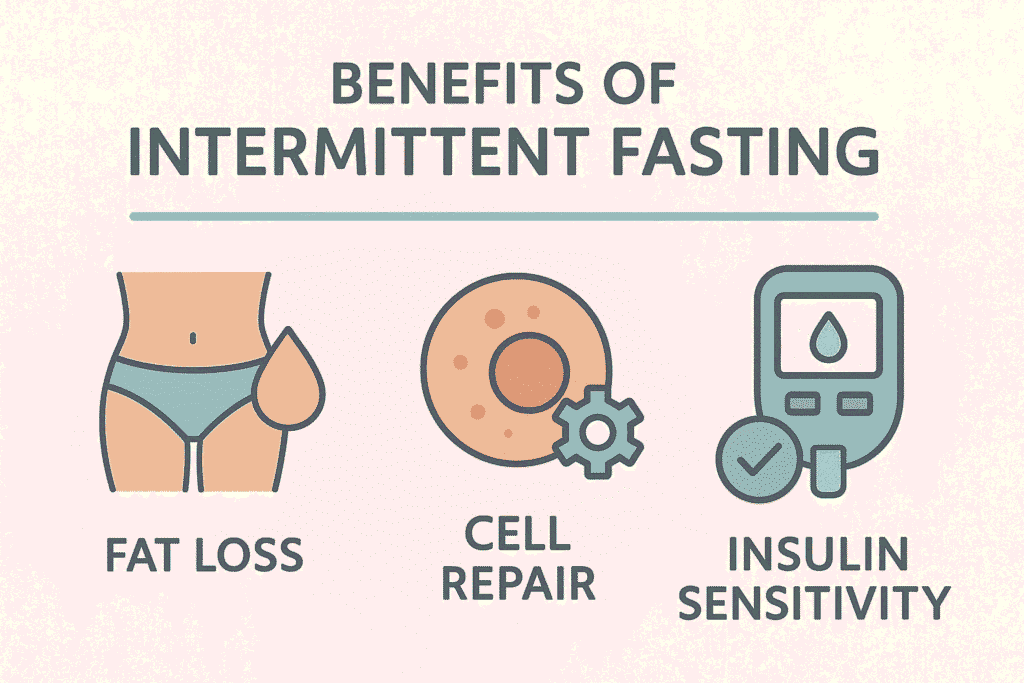What Is Intermittent Fasting? A Beginner’s Overview
Intermittent Fasting (IF) isn’t a diet—it’s a pattern of eating. Instead of focusing on what you eat, IF focuses on when you eat. It involves cycling between periods of eating and fasting, allowing your body to tap into stored fat for energy.

This eating strategy has gained significant popularity, particularly among individuals seeking sustainable weight loss, enhanced mental clarity, and improved long-term health. It’s backed by science, embraced by fitness experts, and practiced across the globe.
How Intermittent Fasting Works: The Science Simplified
Understanding the Fed vs Fasted State
After eating, your body spends several hours in the fed state, processing and storing food. During this time, insulin levels are high, and fat burning is paused.
When you fast, your body enters the fasted state, where insulin levels drop and stored fat becomes the primary energy source. This shift enables weight loss and triggers several beneficial hormonal processes.
The Role of Insulin and Hormones
Fasting lowers insulin, a hormone that helps store fat. When insulin levels are low, fat becomes more accessible. Moreover, intermittent fasting increases norepinephrine (noradrenaline), boosting metabolic rate by up to 14%.
Other key hormonal benefits include:
- Human Growth Hormone (HGH): Promotes muscle gain and fat loss.
- Autophagy: A cellular cleanup process that removes damaged cells.
The Top 7 Types of Intermittent Fasting Explained
1. The 16/8 Method (Leangains Protocol)
One of the most popular methods. You fast for 16 hours and eat all your meals within an 8-hour window, such as noon–8 PM. Ideal for beginners and sustainable long term.
2. The 5:2 Diet
Eat normally for 5 days and reduce calorie intake (500–600 kcal) on 2 non-consecutive days. Great for people who want flexibility in their eating patterns.
3. Eat-Stop-Eat (24-Hour Fasts)
Involves fasting for 24 hours once or twice a week. For example, finishing dinner at 7 PM and not eating until 7 PM the next day.
4. Alternate-Day Fasting (ADF)
As the name suggests, you alternate between fasting days and regular eating days. It may be harder to sustain, but it has strong weight loss effects.
5. Warrior Diet (20/4 Method)
Involves fasting for 20 hours and eating one large meal at night. Encourages whole, unprocessed foods and mimics the eating pattern of ancient warriors.
6. OMAD (One Meal A Day)
You consume all your daily calories in one single meal, usually dinner. It’s a more extreme version, but it provides quick results for some.
7. Spontaneous Skipping of Meals
Simple and flexible—skip meals when you’re not hungry or too busy to eat. This naturally leads to a calorie deficit without rigid schedules.
Which Intermittent Fasting Method Is Best for Fat Loss?
Comparing Weight Loss Across Different IF Protocols
All IF methods promote fat loss by reducing calorie intake and optimizing hormonal levels. However, studies suggest the 16/8 and Alternate-Day Fasting yield the best results for consistent, healthy weight loss.
| Method | Fat Loss Potential | Ease of Adoption |
| 16/8 | Moderate to High | Easy |
| 5:2 | Moderate | Medium |
| OMAD | High | Hard |
| ADF | Very High | Hard |
Tailoring IF to Your Lifestyle and Goals
- Busy professionals often prefer 16/8 due to its simplicity.
- Athletes may consider adopting the OMAD or Warrior Diet for achieving muscle definition.
- Beginners should start with skipping breakfast or 14/10 before moving to stricter forms.
Scientific Benefits of Intermittent Fasting Beyond Weight Loss

Improved Insulin Sensitivity & Blood Sugar Regulation
Fasting reduces insulin resistance, helping manage type 2 diabetes and preventing metabolic disorders.
Enhanced Cellular Repair and Autophagy
Autophagy is a process where the body clears out damaged cells, reducing inflammation, enhancing recovery, and even preventing cancer growth.
Increased Human Growth Hormone (HGH) Production
Fasting boosts HGH by up to 5x, supporting fat loss and muscle preservation.
Reduced Inflammation and Oxidative Stress
Chronic inflammation is linked to aging and disease. IF helps combat this through cellular repair and lowered oxidative markers.
Longevity and Anti-Aging Effects
Animal studies show that IF can increase lifespan by 30–50%. While human research is ongoing, early signs are promising.
Common Myths About Intermittent Fasting Debunked
“You’ll Starve and Lose Muscle”
Wrong! When done correctly, IF preserves lean muscle mass and increases HGH, which protects muscle tissue.
“Skipping Breakfast Is Unhealthy”
There’s no conclusive evidence that skipping breakfast harms metabolism. It depends on what and when you eat, not just breakfast.
Tips for Getting Started with Intermittent Fasting
Building Up Gradually
Start with 12-hour fasts, then move to 14/10 or 16/8. Your body needs time to adapt.
Staying Hydrated and Managing Hunger
Drink water, black coffee, or herbal teas during fasting. Hunger will diminish over time as your body adjusts.
What to Eat During Feeding Windows

Focus on:
- Whole, nutrient-rich foods
- Lean protein
- Healthy fats
- Complex carbs
- Plenty of fiber
Avoid sugary drinks and processed junk—these sabotage fat loss.
Who Should Avoid Intermittent Fasting?
While IF is safe for many, it’s not recommended for:
- Pregnant or breastfeeding women
- People with eating disorders
- Those with certain medical conditions (consult your doctor)
- Children and teens under 18
FAQs About Intermittent Fasting
1. Can I drink coffee during fasting?
Yes, black coffee, tea, and water are allowed and may help curb hunger.
2. Will I lose muscle on intermittent fasting?
Not if you maintain protein intake and strength training. IF preserves muscle mass.
3. Is intermittent fasting safe long-term?
Yes, for most healthy individuals. Always consult a doctor if unsure.
4. Can I exercise while fasting?
Yes! Many people train fasted, especially cardio. Just listen to your body.
5. How soon will I see results with IF?
Many see changes in 2–4 weeks, but consistency is key.
6. Can I do IF while on a keto or low-carb diet?
Absolutely. IF complements keto very well and may enhance fat burning.
Conclusion: Is Intermittent Fasting Right for You?
Intermittent fasting is a powerful tool, not just for fat loss, but for longevity and better health. It’s simple, flexible, and backed by science. Whether you’re aiming to shed pounds, clear brain fog, or improve metabolic health, IF might be the reset your body needs.
Try a method that suits your routine, be consistent, and focus on whole foods. The journey to a healthier, leaner you may just start with skipping breakfast.
